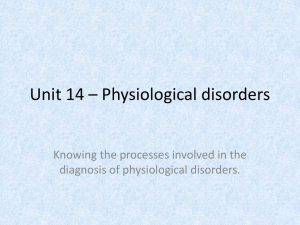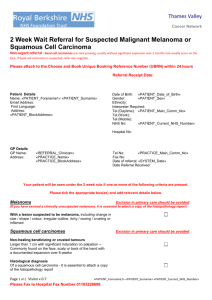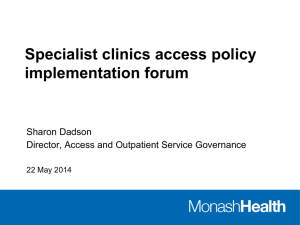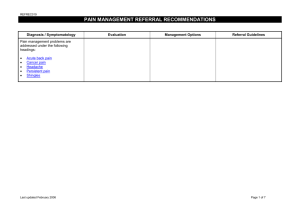HAEMATOLOGY/IMMUNOLOGY
advertisement
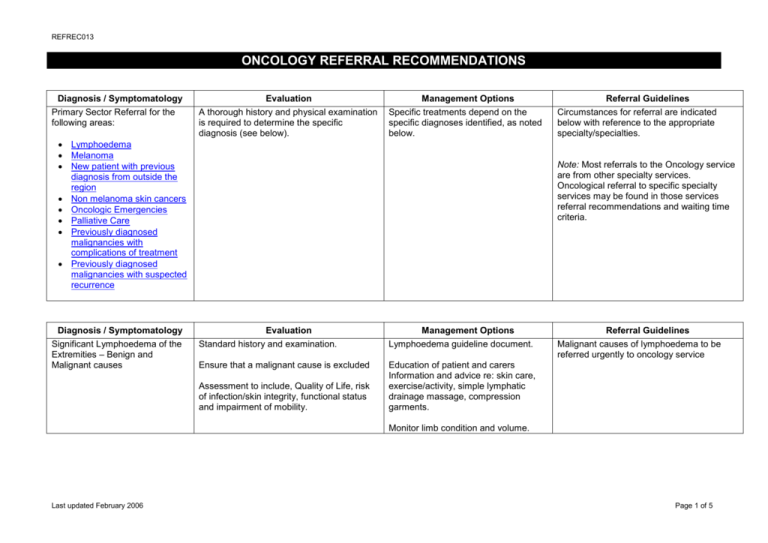
REFREC013 ONCOLOGY REFERRAL RECOMMENDATIONS Diagnosis / Symptomatology Primary Sector Referral for the following areas: Evaluation Management Options A thorough history and physical examination is required to determine the specific diagnosis (see below). Specific treatments depend on the specific diagnoses identified, as noted below. Lymphoedema Melanoma New patient with previous diagnosis from outside the region Non melanoma skin cancers Oncologic Emergencies Palliative Care Previously diagnosed malignancies with complications of treatment Previously diagnosed malignancies with suspected recurrence Diagnosis / Symptomatology Significant Lymphoedema of the Extremities – Benign and Malignant causes Referral Guidelines Circumstances for referral are indicated below with reference to the appropriate specialty/specialties. Note: Most referrals to the Oncology service are from other specialty services. Oncological referral to specific specialty services may be found in those services referral recommendations and waiting time criteria. Evaluation Management Options Standard history and examination. Lymphoedema guideline document. Ensure that a malignant cause is excluded Education of patient and carers Information and advice re: skin care, exercise/activity, simple lymphatic drainage massage, compression garments. Assessment to include, Quality of Life, risk of infection/skin integrity, functional status and impairment of mobility. Referral Guidelines Malignant causes of lymphoedema to be referred urgently to oncology service Monitor limb condition and volume. Last updated February 2006 Page 1 of 5 REFREC013 Diagnosis / Symptomatology Melanoma Evaluation As for Non Melanoma Skin Cancer Also assess 1. 2. 3. 4. Asymmetry Border Colour Diameter Management Options Referral Guidelines Excision biopsy with clear visual margin of 2-5 mm. Do not undermine the edge. All material to be sent for histopathological assessment. Greater than 0.7mm depth requires referral for reexcision +/- skin grafting. Referral to specialist (Dermatologist, Plastics or General Surgeon) if above the practitioner’s skill level for excision (subungual, facial and large lesions etc), if primary closure not possible, if local recurrence (including in-transit or nodal disease) or margins close or positive. Category 2 FNA or excision biopsy if evidence of recurrence or metastases. If metastases confirmed stage with CT scan of chest, abdomen and pelvis (where available). Diagnosis / Symptomatology New patient with previous diagnosis from outside the region Last updated February 2006 Evaluation Standard history and examination. Gain access to previous management files, reports and investigations. Management Options Patient presenting for routine follow-up Vs patient presenting with problems possibly related to history of malignancy Refer all melanomas to specialist with interest in Melanoma for review-category 2. Refer to Oncologist if evidence of metastatic disease. Category 2. Referral Guidelines Refer according to the need for ongoing specialist management (urgent or nonurgent) or review with appropriate timing as per waiting time criteria. Page 2 of 5 REFREC013 Diagnosis / Symptomatology Non Melanoma Skin Cancer Evaluation Standard history and examination, attention to dermatology evaluation. Report 1. 2. 3. 4. Symptoms Size Location Lymph node status Management Options Referral Guidelines Small lesions – excision biopsy No referral if complete excision. Large lesions – excision biopsy if feasible and competency to perform procedure appropriate. Ensure adequate deep and radial margins. Follow-up to confirm recurrence does not occur. If too large to excise in primary care, positive margins or re-excision above practitioners skill level, refer to Plastic Surgeon or Dermatologist. Local recurrence- may attempt reexcision. (Consider need for radiotherapy or plastic surgical input). Metastatic disease – confirm with biopsy, stage with CT scan (where available). If other medical problems making excision difficult, ie local anaesthetic allergy, anticoagulation, corticosteroid use. Very large lesions where radiotherapy, skin grafting or multi-disciplinary approach may be needed. Facial lesions where cosmetic result is important. Oncology referral for metastatic disease. Category 2 for the above indications. Last updated February 2006 Page 3 of 5 REFREC013 Diagnosis / Symptomatology Oncologic Emergencies/Other Acute Presentations Evaluation Standard history and examination History of malignancy or substantial clinical evidence for malignancy Diagnosis / Symptomatology Palliative Care Evaluation Standard history and examination Management Options Emergencies (not a comprehensive list) Spinal cord/cauda equina compression Airway obstruction Hypercalcemia Brain metastasis Superior vena cava obstruction Marked renal or hepatic impairment Management Options Evaluate origin of symptoms with appropriate investigations. Seek specialist Palliative care or Oncology advice for difficult to manage symptomatology Diagnosis / Symptomatology Previously diagnosed malignancies with suspected recurrence Evaluation Standard history and examination Management Options Image as appropriate, eg bone scan, CT scan, X-rays. Referral Guidelines Category 1 referral Referral Guidelines Referral to treating Oncologist for ongoing care eg. Symptomatic care, palliative radiotherapy or palliative chemotherapy. Category 1 for severe uncontrolled and distressing symptoms. Referral Guidelines Referral to oncologist for biopsy, symptomatic care and ongoing management. Category 2 Biopsy if possible to confirm suspicions of recurrence or metastatic disease. Manage symptoms, palliative care service and oncology service may be contacted to advise Last updated February 2006 Page 4 of 5 REFREC013 Diagnosis / Symptomatology Previously diagnosed malignancies with complications of treatment Evaluation Standard history and examination Management Options Seek advice from treating specialist Referral Guidelines Patients who are receiving or who have recently received chemotherapy/radiotherapy and are septic and neutropenic should be referred for immediate assessment. Category 1 If febrile during a course of therapy and neutrophil status is not readily available refer for immediate assessment. Category 1 Patients with severe gastrointestinal complications eg severe mucositis uncontrolled vomiting or diarrhoea should be discussed with the treating specialist with a view to immediate management and possible admission. Category 1 Non-acute side effects or complications of a non-life-threatening nature to be referred as non-urgent. May be discussed with the treating specialist. Last updated February 2006 Page 5 of 5



